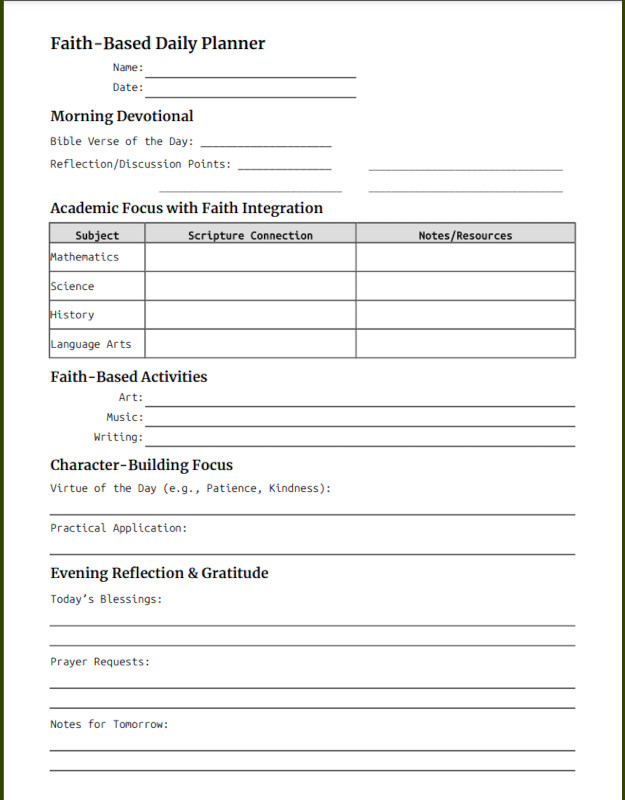Faith-Based Homeschooling Planner

Introduction
Incorporating faith into your homeschooling routine is a powerful way to nurture your children’s spiritual growth alongside their academic learning. As someone who has homeschooled my children across seven countries as a Christian missionary, I know the joy and challenges of weaving faith into education. This guide will provide strategies, resources, and a daily planner to help you integrate your family’s faith into your homeschool environment seamlessly.
Why Incorporate Faith into Homeschooling?
Faith-based homeschooling is not just about including Bible lessons in your curriculum—it’s about shaping character, building a strong moral foundation, and fostering a deep relationship with God. It provides opportunities to:
- Integrate Biblical Principles: Teach math, history, and science through the lens of faith.
- Create Meaningful Discussions: Use scripture to guide family conversations about values and life lessons.
- Develop a Christ-Centered Worldview: Equip your children with the tools to navigate the world with integrity and confidence in their faith.
Practical Steps to Incorporate Faith
1. Start the Day with Devotion
Begin each morning with prayer or a family devotional. This sets a positive tone for the day and reminds everyone of the larger purpose of your homeschooling journey.
2. Choose Faith-Based Curriculums
Select materials designed to integrate faith with academic subjects. Some popular options include:
- Sonlight: Literature-based learning with a Biblical perspective.
- Abeka: Traditional academics with a focus on scripture.
- My Father’s World: Combines Charlotte Mason and unit study approaches with faith.
3. Bible Verses for Each Subject
Incorporate relevant scripture into your daily subjects. For example:
- Math: Proverbs 16:11 – “Honest scales and balances belong to the Lord.”
- Science: Psalm 19:1 – “The heavens declare the glory of God.”
- History: Ecclesiastes 3:1 – “To everything there is a season, and a time to every purpose under the heaven.”
4. Include Faith in Activities
- Art: Create scripture-inspired projects.
- Music: Learn hymns or explore Christian composers.
- Writing: Encourage journaling about faith experiences or reflections on Bible stories.
5. Reflect with Gratitude
End each day by discussing what everyone is grateful for and how God’s hand was evident during their learning.
Resources for Faith-Based Homeschooling
- Devotional Books for Kids: Choose age-appropriate devotionals to start your day.
- Scripture Memory Tools: Apps like Bible Memory or printable verse cards.
- Faith-Inspired Stories: Use books with Christian themes to teach reading comprehension.
Faith-Based Daily Planner
To make integrating faith into your day easier, use the planner template below. It includes space to outline your devotionals, faith-based lessons, and other key elements of your homeschool routine.

